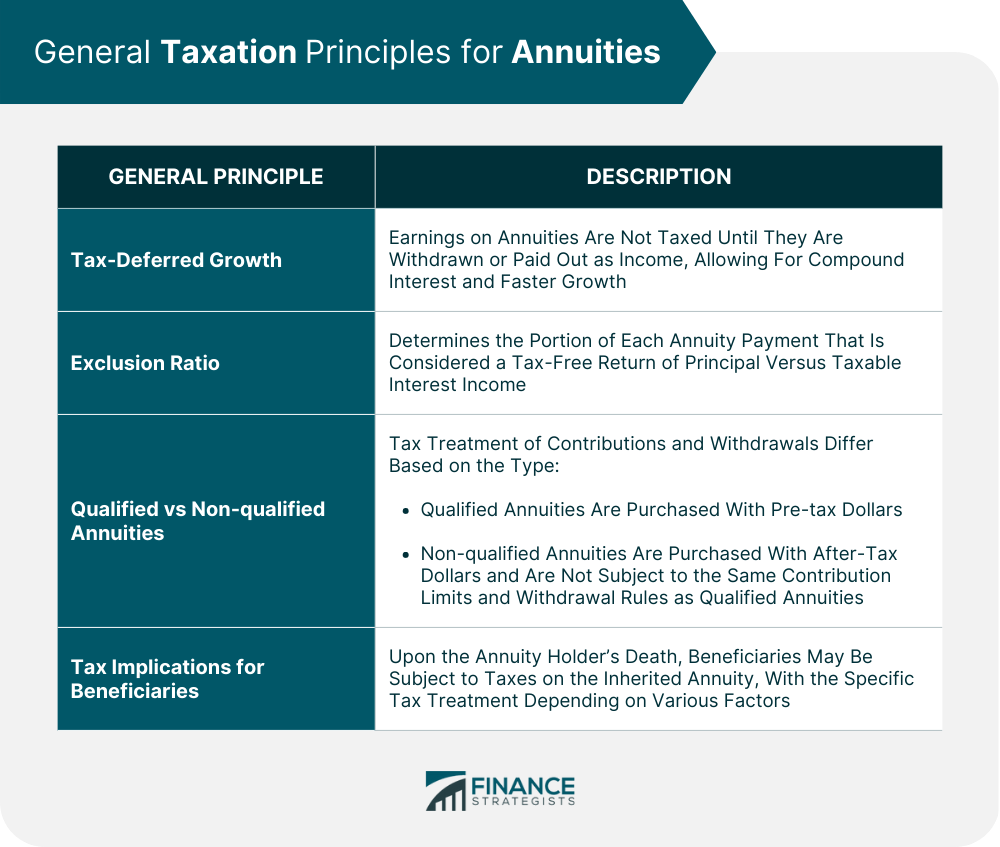All Categories
Featured
Table of Contents

Recognizing the different fatality benefit options within your acquired annuity is essential. Very carefully review the agreement details or consult with a monetary advisor to identify the specific terms and the very best way to proceed with your inheritance. When you acquire an annuity, you have a number of choices for receiving the money.
In many cases, you could be able to roll the annuity right into a special sort of private retired life account (IRA). You can pick to obtain the whole staying balance of the annuity in a single payment. This choice offers prompt accessibility to the funds but includes major tax obligation repercussions.
.jpg)
If the acquired annuity is a qualified annuity (that is, it's held within a tax-advantaged retirement account), you might be able to roll it over into a new retirement account (Fixed annuities). You don't need to pay tax obligations on the rolled over amount.
Structured Annuities inheritance taxation
Other sorts of recipients normally should withdraw all the funds within one decade of the proprietor's death. While you can't make extra payments to the account, an inherited IRA offers a useful advantage: Tax-deferred development. Earnings within the acquired IRA build up tax-free until you start taking withdrawals. When you do take withdrawals, you'll report annuity revenue in the exact same means the strategy participant would certainly have reported it, according to the internal revenue service.
This choice supplies a steady stream of income, which can be beneficial for long-term financial preparation. Generally, you need to begin taking distributions no much more than one year after the owner's fatality.
As a recipient, you will not be subject to the 10 percent internal revenue service early withdrawal penalty if you're under age 59. Trying to compute tax obligations on an inherited annuity can feel complex, yet the core principle focuses on whether the added funds were formerly taxed.: These annuities are funded with after-tax dollars, so the recipient usually doesn't owe tax obligations on the initial payments, yet any earnings built up within the account that are distributed are subject to common earnings tax obligation.
How are Annuity Income taxed when inherited
There are exceptions for partners who inherit certified annuities. They can usually roll the funds into their own individual retirement account and postpone tax obligations on future withdrawals. Regardless, at the end of the year the annuity company will submit a Form 1099-R that demonstrates how a lot, if any type of, of that tax year's circulation is taxed.
These taxes target the deceased's complete estate, not simply the annuity. Nevertheless, these taxes generally just effect huge estates, so for many heirs, the focus ought to be on the revenue tax obligation effects of the annuity. Inheriting an annuity can be a facility however possibly monetarily beneficial experience. Comprehending the regards to the agreement, your payout options and any type of tax obligation effects is vital to making notified choices.
What taxes are due on inherited Annuity Cash Value
Tax Treatment Upon Death The tax therapy of an annuity's fatality and survivor benefits is can be quite made complex. Upon a contractholder's (or annuitant's) fatality, the annuity might go through both income taxes and estate tax obligations. There are different tax treatments relying on that the recipient is, whether the owner annuitized the account, the payment approach chosen by the beneficiary, etc.
Estate Taxation The government inheritance tax is a very modern tax (there are several tax obligation brackets, each with a greater price) with prices as high as 55% for really big estates. Upon death, the internal revenue service will certainly consist of all property over which the decedent had control at the time of death.
Any tax obligation in unwanted of the unified credit scores is due and payable nine months after the decedent's death. The unified credit report will completely shelter fairly small estates from this tax.
This conversation will certainly concentrate on the estate tax obligation therapy of annuities. As held true during the contractholder's life time, the internal revenue service makes a critical distinction in between annuities held by a decedent that remain in the buildup phase and those that have actually entered the annuity (or payment) stage. If the annuity remains in the accumulation phase, i.e., the decedent has actually not yet annuitized the contract; the full survivor benefit ensured by the agreement (including any type of boosted fatality benefits) will be consisted of in the taxed estate.
How are beneficiaries taxed on Annuity Income
Instance 1: Dorothy had a taken care of annuity agreement released by ABC Annuity Business at the time of her fatality. When she annuitized the contract twelve years back, she chose a life annuity with 15-year period particular. The annuity has actually been paying her $1,200 per month. Considering that the agreement warranties settlements for a minimum of 15 years, this leaves three years of payments to be made to her child, Ron, her assigned recipient (Variable annuities).

That value will be included in Dorothy's estate for tax obligation functions. Upon her fatality, the repayments stop-- there is absolutely nothing to be paid to Ron, so there is nothing to consist of in her estate.
Two years ago he annuitized the account choosing a lifetime with money refund payment alternative, naming his daughter Cindy as recipient. At the time of his death, there was $40,000 principal staying in the agreement. XYZ will pay Cindy the $40,000 and Ed's administrator will certainly consist of that quantity on Ed's inheritance tax return.
Because Geraldine and Miles were married, the benefits payable to Geraldine stand for residential property passing to an enduring partner. Variable annuities. The estate will have the ability to use the unlimited marital reduction to avoid tax of these annuity benefits (the value of the benefits will certainly be detailed on the inheritance tax form, along with a balancing out marital reduction)
Tax implications of inheriting a Joint And Survivor Annuities
In this instance, Miles' estate would certainly consist of the worth of the staying annuity repayments, yet there would be no marriage reduction to balance out that incorporation. The same would use if this were Gerald and Miles, a same-sex pair. Please note that the annuity's continuing to be value is figured out at the time of fatality.

Annuity contracts can be either "annuitant-driven" or "owner-driven". These terms refer to whose fatality will set off settlement of fatality benefits.
There are situations in which one person possesses the contract, and the determining life (the annuitant) is someone else. It would behave to think that a specific agreement is either owner-driven or annuitant-driven, but it is not that simple. All annuity agreements released given that January 18, 1985 are owner-driven due to the fact that no annuity agreements released ever since will be given tax-deferred condition unless it includes language that triggers a payment upon the contractholder's death.
Table of Contents
Latest Posts
Understanding Fixed Index Annuity Vs Variable Annuity A Comprehensive Guide to Variable Vs Fixed Annuity Breaking Down the Basics of Investment Plans Benefits of Annuity Fixed Vs Variable Why What Is
Decoding Annuities Fixed Vs Variable Everything You Need to Know About Fixed Vs Variable Annuity Pros Cons What Is the Best Retirement Option? Benefits of Choosing the Right Financial Plan Why Choosin
Decoding How Investment Plans Work A Closer Look at How Retirement Planning Works What Is the Best Retirement Option? Pros and Cons of Fixed Annuity Vs Variable Annuity Why Choosing the Right Financia
More
Latest Posts